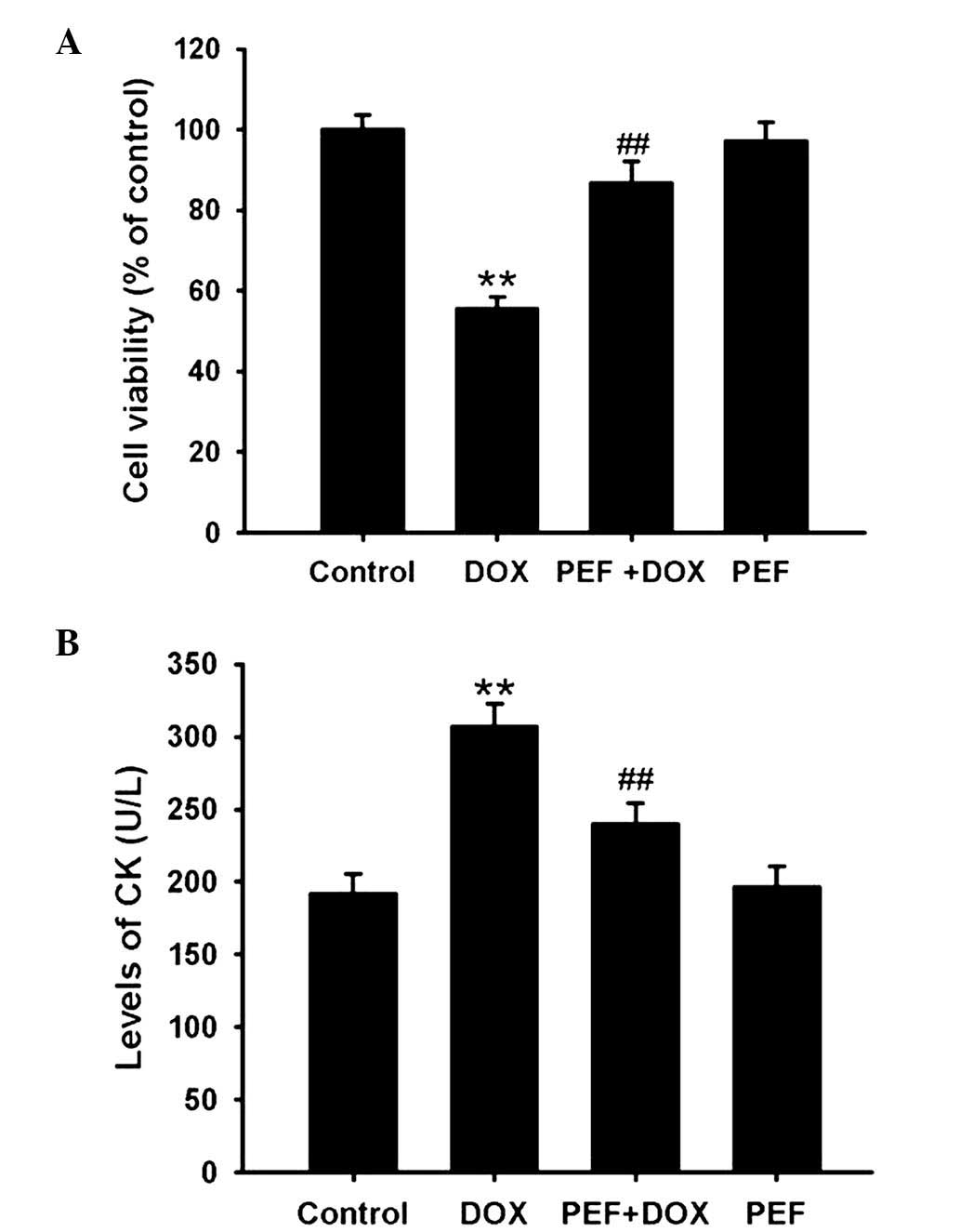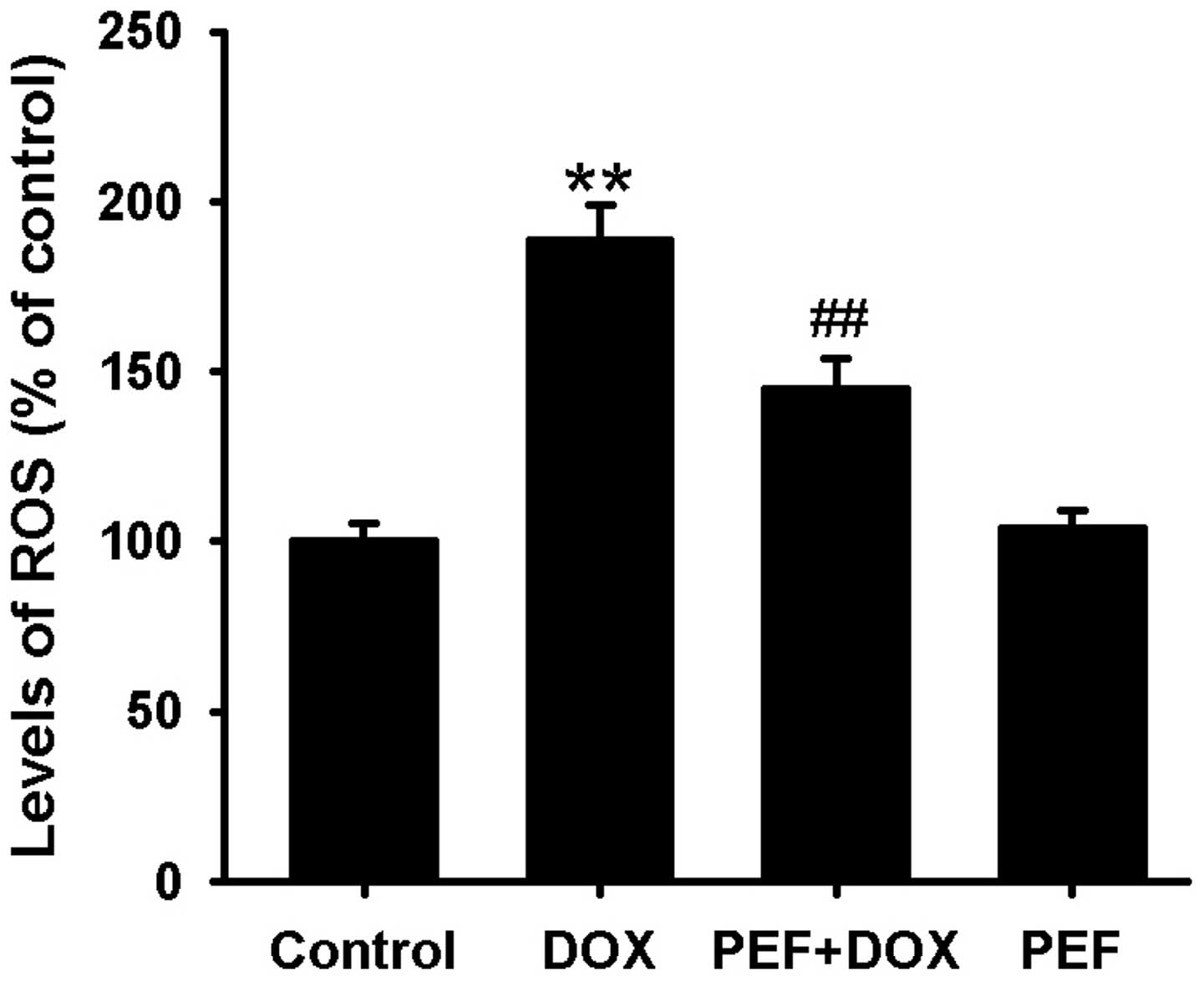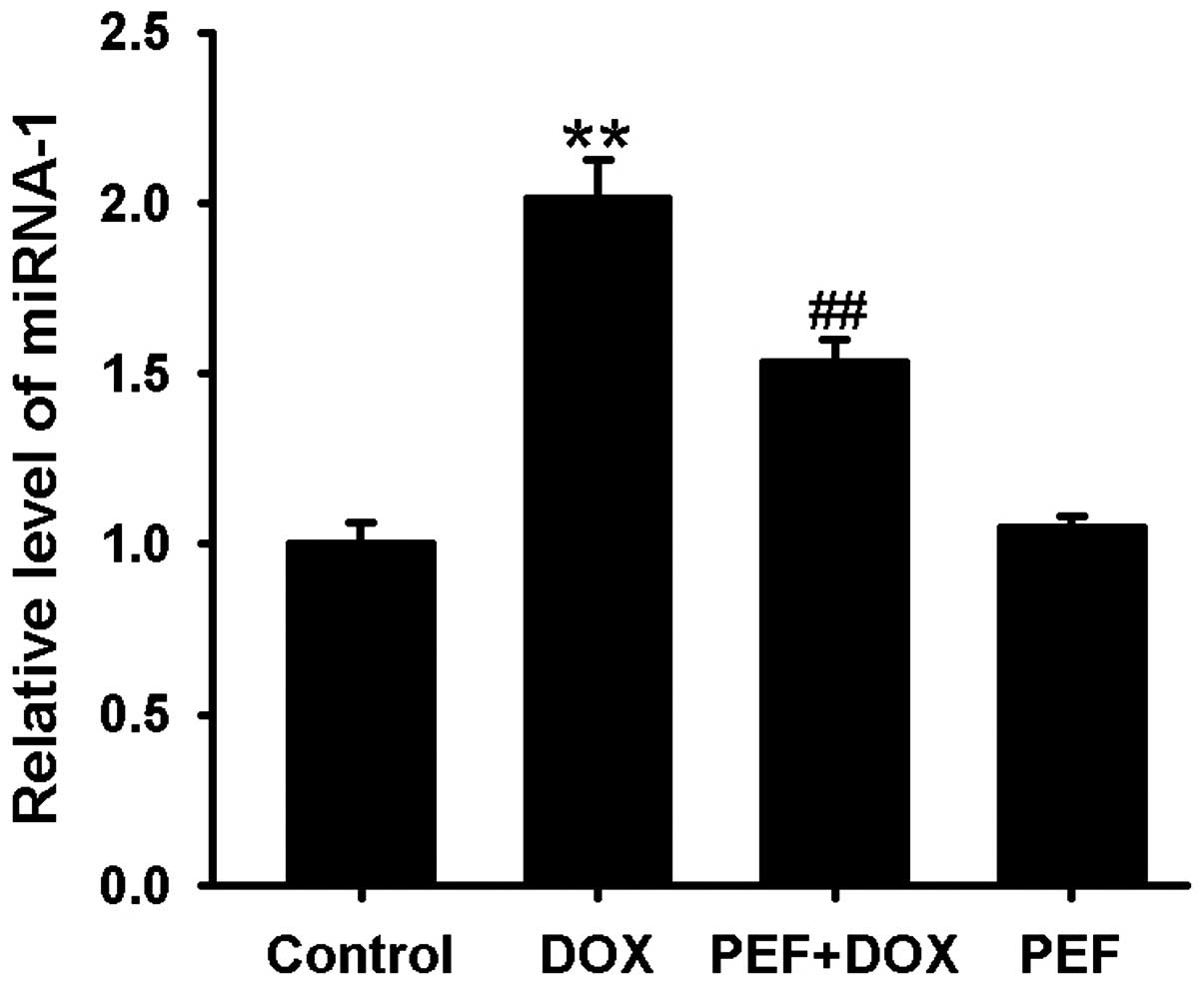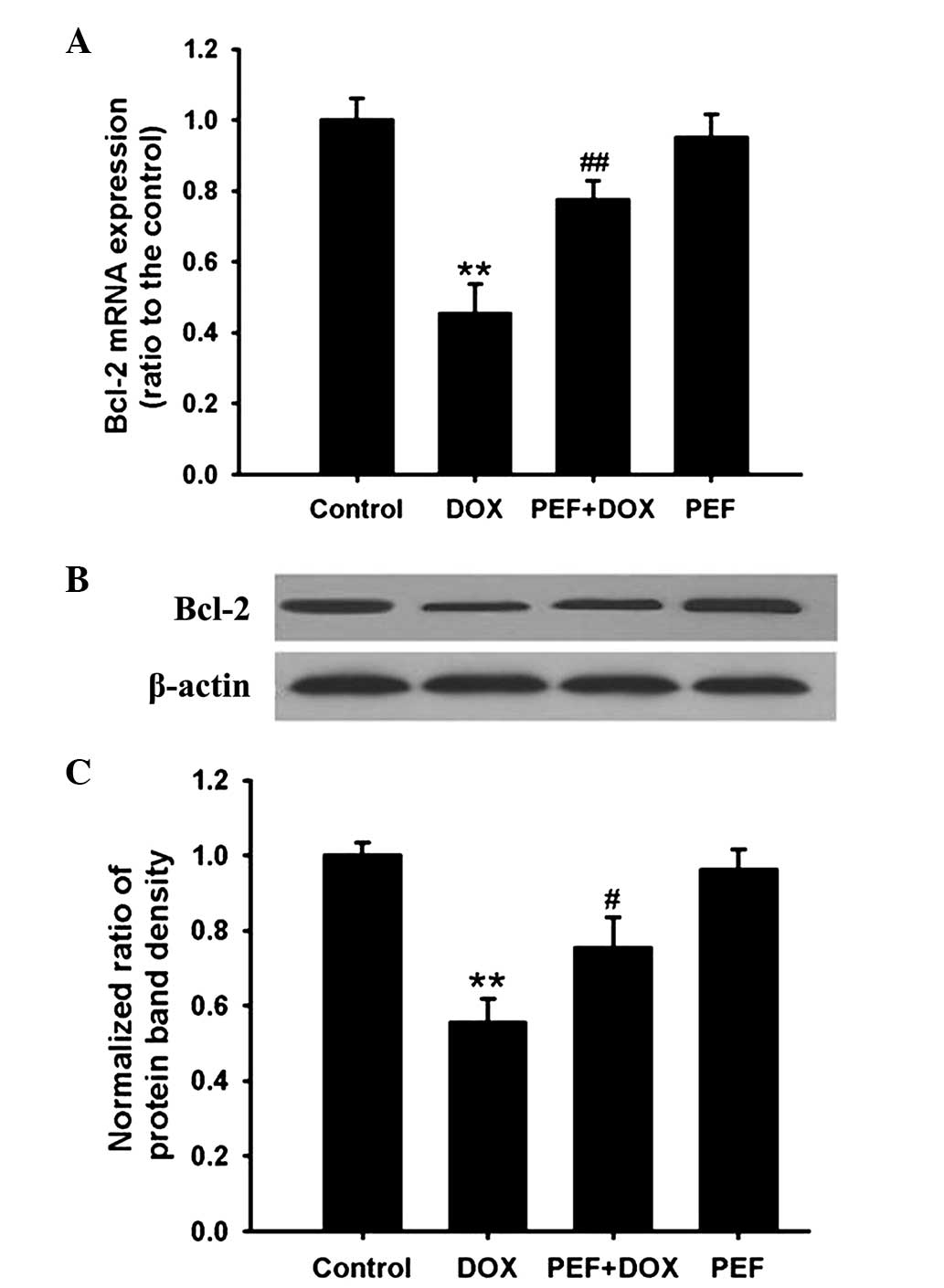Paeoniflorin inhibits doxorubicin-induced cardiomyocyte apoptosis by downregulating microRNA-1 expression
- Authors:
- Published online on: March 24, 2016 https://doi.org/10.3892/etm.2016.3182
- Pages: 2407-2412
Abstract
Introduction
Doxorubicin (DOX) is an effective anthracycline antitumor antibiotic and is extensively used for treatment of numerous types of malignant tumors, including osteosarcoma, breast carcinoma and lung cancer (1–3). However, because of cumulative and dose-dependent cardiotoxicity, the clinical application of DOX is limited. Although the exact physiopathological mechanism of DOX-induced cardiotoxicity is not yet understood, cardiomyocyte apoptosis is acknowledged to play an important role in DOX-associated cardiotoxicity (4,5).
MicroRNAs (miRs) are a class of endogenous non-coding RNAs of ~22 nucleotides, which participate in the regulation of protein-coding gene expression by binding to the 3′-untranslated regions of target mRNA at the post-transcriptional level (6). It has been predicted that there are >1,000 miRs in the human genome, and miRs are estimated to regulate as many as 60% of all human mRNAs (7,8). It is well recognized that miRs play important roles in a large variety of physiological and pathological processes, such as embryonic development, tumor formation and modulation of the inflammatory response (9–11). Among the known miRs, miR-1 is a muscle-enriched miR and highly expressed in the myocardium (12). Therefore, aberrant expression of miR-1 is closely associated with myocardial diseases. It has been reported that miR-1 expression is markedly increased in ischemia/reperfusion (IR) or hypoxia/reoxygenation-induced cardiac myocyte apoptosis (13). In addition, in miR-1 transgenic mice, cardiac myocyte apoptosis was found to be exacerbated compared with that in wild-type mice when subjected to myocardial IR injury; by contrast, knockdown of miR-1 using a locked nucleic acid-modified oligonucleotide against miR-1 significantly attenuated IR-induced cardiac myocyte apoptosis (14). However, the role of miR-1 in DOX-induced cardiomyocyte apoptosis is not understood.
Paeoniflorin (PEF), a monoterpene glucoside, is the major active ingredient of Paeonia lactiflora Pall. (family Paeoniaceae), which is a traditional Chinese herbal medicine that has been used in China for >1,000 years. It has been reported that PEF exerts multiple pharmacological activities, such as inhibition of tumor invasion and metastasis (15), reduction of inflammatory factor production (16), prevention of insulin resistance (17) and neuroprotective effects (18). Our previous study demonstrated that PEF was able to inhibit DOX-induced cardiomyocyte apoptosis by reducing the production of reactive oxygen species (ROS) (19); however, the downstream mechanism remains unclear.
In the present study, the role of miR-1 in DOX-induced cell apoptosis was explored using a cultured H9c2 rat cardiomyocyte cell line, and whether the anti-apoptotic effect of PEF was related to a regulatory effect on miR-1 expression was investigated.
Materials and methods
Materials
The H9c2 cell line was acquired from Academia Sinica (Shanghai, China). PEF was obtained from Yangling Dongke Maidisen Pharmaceutical Co., Ltd. (Xi'an, China). DOX was purchased from Sigma-Aldrich (St. Louis, MO, USA). Dulbecco's modified Eagle's medium (DMEM) and fetal bovine serum (FBS) were from Gibco (Thermo Fisher Scientific, Inc., Waltham, MA, USA). mirVana miR isolation kits and TaqMan™ miR Reverse Transcription kits were purchased from Applied Biosystems (Thermo Fisher Scientific, Inc.). B-cell lymphoma 2 (Bcl-2; ab59348) and β-actin (ab1801) antibodies were from Abcam (Cambridge, UK). The following were purchased from Beyotime Institute of Biotechnology (Jiangsu, China): 3-(4,5-Dimethylthiazol-2-yl)-2,5-diphenyl tetrazolium bromide (MTT), Hoechst 33342 fluorescent dye and reactive oxygen species (ROS) detection kit. The creatine kinase (CK) assay kit was acquired from Nanjing Jiancheng Bioengineering Institute (Nanjing, China).
Cell culture and treatment
H9c2 cells were cultured in DMEM containing 15% (v/v) FBS. The medium was supplemented with 100 U/ml penicillin (Guangzhou Baiyunshan Tianxin Pharmaceutical Co., Ltd., Guangdong, China) and 100 µg/ml streptomycin (Harbin Pharmaceutical Group Holding Co., Ltd., Heilongjiang, China). All cells were grown under a humidified atmosphere of 5% CO2 at 37°C. The medium was changed every 2–3 days. When cells reached 80% confluence, they were made quiescent by serum starvation (0.5% FBS) for 24 h, and then the cells were randomly allocated to 4 groups: i) The control group (cultured in normal condition); ii) the DOX group (incubated with 5 µmol/l DOX for 24 h); iii) the PEF + DOX group (cells were treated with 100 µmol/l PEF for 2 h prior to exposure to 5 µmol/l DOX for 24 h); and iv) the PEF group (incubated with 100 µmol/l PEF for 26 h).
Evaluation of cell injury
Cell viability was assessed by MTT assay. Briefly, following DOX treatment, the medium was aspirated, and the cells were washed twice with PBS, then 0.5 mg/ml MTT solution was added to each well and the plate was incubated for 4 h at 37°C in an atmosphere of 5% CO2. After that, 100 µl dimethysulfoxide (DMSO) was added to dissolve formazan. The absorbance was read at 490 nm using a microplate reader (Molecular Devices, Sunnyvale, CA, USA). Cell viability was expressed as a percentage of the control. The activity of CK, an indicator of cardiomyocyte injury, was detected using a commercially available colorimetric assay kit according to the manufacturer's protocol.
Measurement of cardiomyocyte apoptosis
Apoptotic cells were detected by Hoechst 33342 fluorescent dye using an inverted fluorescence microscope (Nikon Eclipse TE-2000; Nikon Corporation, Tokyo, Japan). Briefly, after DOX treatment, the medium was aspirated, and the cells were washed twice with PBS. After that, cells were incubated with Hoechst 33342 (0.1 mg/ml) in the dark at 37°C for 20 min. Hoechst-stained nuclei were detected by inverted fluorescence microscopy at an emission wavelength of 521 nm. The data are expressed as a percentage of apoptotic cells to total cells.
Determination of intracellular ROS
The levels of intracellular ROS were measured using 2′,7′-dichlorofluorescein diacetate, a well characterized probe. Briefly, following DOX treatment, the medium was aspirated and cells were washed three times with serum-free DMEM. After that, cells were incubated with 2′,7′-dichlorofluorescein diacetate at a final concentration of 10 µM in the dark at 37°C for 20 min. The fluorescence intensity was measured using a fluorospectrophotometer (Shimadzu Corporation, Kyoto, Japan) at an excitation wavelength at 488 nm and an emission wavelength at 525 nm. The data are expressed as a percentage of the control.
Quantitative polymerase chain reaction (qPCR)
miR-1 expressionFollowing treatment, total RNA was isolated from H9c2 cells using the mirVana miR isolation kit according to the manufacturer's protocol. cDNA was synthesized from 1 µg total RNA using the TaqMan™ miR reverse transcription kit (Promega Corporation, Madison, WI, USA). cDNA was diluted 15-fold and then used in PCR reactions. Reactions contained specific primers for miR-1 or U6; the latter was used as an internal control. The primer sequences were as follows: miR-1 forward, 5′-ACACTCCAGCTGGGGTGTGGAATGTA-3′ and reverse, 5′-TGGTGTCGTGGAGTCG-3; U6 forward, 5′-ACACTCCAGCTGGGGTGCTCGCTTCGGCAGCACA-3′ and reverse, 5′-AGGGTCCGAGGTATTC-3′. PCR was performed using TaqMan universal PCR master mix (Applied Biosystems; Thermo Fisher Scientific, Inc.) with the following conditions: 10 min at 95°C followed by 40 cycles of 95°C for 15 sec and 60°C for 1 min. All amplification reaction for each sample was carried out four times. The relative expression values were normalized to the expression of U6 using the 2−ΔΔCq method (20).
Bcl-2 mRNA expressionFollowing treatment, total RNA was isolated using TRIzol reagent (Invitrogen; Thermo Fisher Scientific, Inc.) and quantified by measuring the optical density at 260 nm. 1 µg RNA from each sample was reverse-transcribed to cDNA using an M-MLV reverse transcriptase kit, and then cDNA was used for qPCR. Bcl-2 mRNA expression was quantitatively analyzed using an Applied Biosystems 7300 Real-Time PCR system with a Power SYBR Green PCR Master Mix kit (both Thermo Fisher Scientific, Inc.). PCR primers were as follows: Bcl-2 primers: forward, 5′-CCGGGAGAACAGGGTATGATAA-3′ and reverse, 5′-CCCACTCGTAGCCCCTCTG-3′; glyceraldehyde 3-phosphate dehydrogenase (GAPDH) primers: forward, 5′-TGGCCTCCAAGGAGTAAGAAAC-3′ and reverse, 5′-GGCCTCTCTCTTGCTCTCAGTATC-3′. The PCR amplification program involved initial denaturation at 95°C for 10 min, followed by 40 cycles of denaturation at 95°C for 15 sec and annealing at 60°C for 60 sec. All amplification reactions for each sample were carried out four times, and the relative expression values were normalized to the expression value of GAPDH using the 2−ΔΔCq method (20).
Western blot analysisThe protein expression of Bcl-2 was detected by western blot analysis. Briefly, following the various treatments, cells were lysed with ice-cold lysis buffer, and the protein concentration was measured using a Bradford protein assay (Beyotime Institute of Biotechnology, Inc.). Equal amounts of protein were separated by 10% sodium dodecyl sulfate-polyacrylamide gel electrophoresis and transferred to a nitrocellulose membrane. After transferring the protein samples, the membranes were blocked using 5% milk powder in Tris-buffered saline and Tween 20 at room temperature for 1 h and then incubated with primary rabbit polyclonal antibodies for Bcl-2 and β-actin (both 1:1,000 dilution) overnight at 4°C, followed by incubation with the corresponding goat anti-rabbit horseradish peroxidase-conjugated secondary antibody (1:5,000 dilution; ab175773; Abcam) for 1 h at room temperature. The protein bands were scanned and densitometrically analyzed using an automatic image analysis system (Alpha Innotech Corporation, San Loandra, CA, USA), and the results were normalized to β-actin expression.
Statistical analysisData are presented as means ± standard error of the mean. All values were analyzed using analysis of variance and the Newman-Keuls Student's t-test. P<0.05 was considered to indicate a statistically significant difference.
Results
Effect of PEF on DOX-induced cell injury
The MTT assay showed that cell viability was clearly decreased following DOX treatment, and this reduction in viability was significantly attenuated by pretreatment with PEF for 2 h (P<0.01; Fig. 1A). In line with the MTT assay results, the levels of CK were markedly increased following incubation with DOX, and this effect of DOX was also significantly inhibited by pretreatment with PEF (P<0.01; Fig. 1B). However, PEF alone had no effect on cell viability or the levels of CK.
Effect of PEF on DOX-induced apoptosis
Cardiomyocyte apoptosis was measured by Hoechst 33342 staining. The results showed that DOX treatment notably increased the ratio of apoptotic cells compared with that in the control group. However, pretreatment with PEF for 2 h significantly inhibited DOX-induced cell apoptosis (P<0.01; Fig. 2). PEF alone had no effect on cardiomyocyte apoptosis.
Effect of PEF on DOX-induced intracellular ROS production
The levels of intracellular ROS, indicated by the 2′,7′-dichloroflurorescein fluorescence intensity, were notably increased in DOX-treated cells compared with control cells. However, pretreatment with PEF for 2 h significantly suppressed the intracellular ROS production induced by DOX (P<0.01; Fig. 3). PEF alone had no such effect.
Effect of PEF on DOX-induced miR-1 expression
miR-1 expression was markedly upregulated after DOX treatment compared with that in the control group. This effect of DOX was significantly inhibited by pretreatment with PEF for 2 h (P<0.01; Fig. 4). PEF alone had no effect on miR-1 expression.
Effect of PEF on Bcl-2 expression
PCR analysis showed that the mRNA expression of Bcl-2, an anti-apoptotic gene, was significantly downregulated in DOX-treated cells (P<0.01). Consistent with these results, Bcl-2 protein expression was also markedly decreased after incubation with DOX (P<0.01). However, these effects induced by DOX were inhibited by pretreatment with PEF for 2 h (P<0.01 and P<0.05, respectively; Fig. 5). PEF alone had no effect on Bcl-2 expression.
Discussion
In the current study, it was found that DOX-induced cardiomyocyte apoptosis was accompanied by increased intracellular ROS production, upregulated miR-1 expression and downregulated Bcl-2 mRNA and protein expression. These effects of DOX were markedly inhibited by pretreatment with PEF. These results indicate that the anti-apoptotic effect of PEF was associated with a reduction in ROS production and downregulation of miR-1 expression.
It is acknowledged that cardiomyocyte apoptosis plays an important role in DOX-induced cardiotoxicity (4,5). However, the exact mechanism of DOX-induced cardiomyocyte apoptosis is not fully understood. miR-1 is a muscle-specific miR and highly expressed in the myocardium (12). The abnormal expression of miR-1 is involved in a number of heart diseases. It has been reported that changes in miR-1 expression are associated with, for example, arrhythmia, myocardial infarction, cardiac remodeling and heart failure (21). There is evidence that upregulated miR-1 expression is closely associated with cardiomyocyte apoptosis; in models of IR-, high glucose- or H2O2-induced cardiomyocyte apoptosis, miR-1 expression has been shown to be significantly increased (13,22,23). Further studies have found that the level of miR-1 is inversely correlated with the expression of Bcl-2, which is an anti-apoptotic protein that has been demonstrated to be a potential target of miR-1 (13,23). Overexpression of miR-1 has been shown to exacerbate cardiomyocyte apoptosis induced by IR in mouse models, while knockdown of miR-1 expression significantly attenuated cardiac injury (14). The aforementioned studies suggest that upregulated expression of miR-1 plays a critical role in cardiomyocyte apoptosis via the post-transcriptional repression of Bcl-2 expression, and reducing miR-1 expression may be a promising strategy for the prevention of cardiomyocyte apoptosis.
The mechanism by which miR expression is regulated is not fully clear. A number of factors, including ultraviolet radiation and tertiary-butyl hydroperoxide can lead to changes in the expression of multiple miRs, which is closely associated with increased ROS production (24,25). Schmelzer et al (26) have demonstrated that bacterial lipopolysaccharide induces miR-146a expression via a ROS-dependent pathway as this effect was inhibited by pretreatment with the antioxidant ubiquinol-10. Furthermore, the expression of multiple miRs, including miR-1, was found to change after treatment with H2O2 (27,28). These studies suggest that miR expression may be modulated by ROS. A number of studies have demonstrated that DOX-induced cardiomyocyte apoptosis is closely associated with excessive ROS production (29,30). Therefore, we hypothesized that DOX-induced cardiomyocyte apoptosis may be associated with upregulation of miR-1 expression by an increase in ROS production. In the present study, it was indeed found that DOX significantly increased ROS generation concomitantly with upregulation of miR-1 expression. Thus, reduction of ROS production may be an effective method for inhibiting DOX-induced cardiomyocyte apoptosis via the downregulation of miR-1 expression.
PEF, a monoterpene glucoside extracted from the dry root of Paeonia lactiflora, has been reported to exert multiple pharmacological activities (15–18). Studies have suggested that PEF has anti-oxidative activity (19,31). Furthermore, our previous study demonstrated that PEF was able to inhibit DOX-induced cardiomyocyte apoptosis by reducing ROS production (19), but the downstream mechanism was not clear. Since miR-1 expression is regulated by ROS, and PEF has an anti-oxidative property, we speculated that the anti-apoptotic effect of PEF may be associated with downregulation of miR-1 expression via inhibition of ROS production. In the present study, it was confirmed that PEF markedly inhibited ROS generation, which was accompanied by downregulation of miR-1 expression.
In summary, the results of the current study suggest that the upregulation of miR-1 expression plays an important role in DOX-induced cardiomyocyte apoptosis by the post-transcriptional repression of Bcl-2 expression. Furthermore, the inhibitory effect PEF against DOX-induced cardiomyocyte apoptosis may be associated with the downregulation of miR-1 expression via a reduction in ROS production.
Acknowledgements
This study was supported by the National Nature Science Foundation of China (grant no. 81460613 to J.Z. Li, 81101476 to S.Y. Yu and 81260337 to L.J. Liu), the Guangxi Nature Science Foundation of China (grant no. 2013GXNSFBA019126 to J.Z. Li], the Bureau of Public Health of Guangxi Province (grant no. Z2013206) and the Guangxi Administration of Traditional Chinese Medicine (grant no. GZZC14-36).
References
|
Tacar O, Indumathy S, Tan ML, Baindur-Hudson S, Friedhuber AM and Dass CR: Cardiomyocyte apoptosis vs autophagy with prolonged doxorubicin treatment: Comparison with osteosarcoma cells. J Pharm Pharmacol. 67:231–243. 2015. View Article : Google Scholar : PubMed/NCBI | |
|
Rastegar H, Ashtiani Ahmadi H, Anjarani S, Bokaee S, Khaki A and Javadi L: The role of milk thistle extract in breast carcinoma cell line (MCF-7) apoptosis with doxorubicin. Acta Med Iran. 51:591–598. 2013.PubMed/NCBI | |
|
Shi X, Li C, Gao S, Zhang L, Han H, Zhang J, Shi W and Li Q: Combination of doxorubicin-based chemotherapy and polyethylenimine/p53 gene therapy for the treatment of lung cancer using porous PLGA microparticles. Colloids Surf B Biointerfaces. 122:498–504. 2014. View Article : Google Scholar : PubMed/NCBI | |
|
Gao S, Li H, Cai Y, Ye JT, Liu ZP, Lu J, Huang XY, Feng XJ, Gao H, Chen SR, et al: Mitochondrial binding of α-enolase stabilizes mitochondrial membrane: Its role in doxorubicin-induced cardiomyocyte apoptosis. Arch Biochem Biophys. 542:46–55. 2014. View Article : Google Scholar : PubMed/NCBI | |
|
Li D, Li J, An Y, Yang Y and Zhang SQ: Doxorubicin-induced apoptosis in H9c2 cardiomyocytes by NF-κB dependent PUMA upregulation. Eur Rev Med Pharmacol Sci. 17:2323–2329. 2013.PubMed/NCBI | |
|
Vimalraj S and Selvamurugan N: MicroRNAs expression and their regulatory networks during mesenchymal stem cells differentiation toward osteoblasts. Int J Biol Macromol. 66:194–202. 2014. View Article : Google Scholar : PubMed/NCBI | |
|
Palmero EI, de Campos SG, Campos M, de Souza NC, Guerreiro ID, Carvalho AL and Marques MM: Mechanisms and role of microRNA deregulation in cancer onset and progression. Genet Mol Biol. 34:363–370. 2011. View Article : Google Scholar : PubMed/NCBI | |
|
Harries LW: MicroRNAs as Mediators of the ageing process. Genes (Basel). 5:656–670. 2014.PubMed/NCBI | |
|
Eshel O, Shirak A, Dor L, Band M, Zak T, Markovich-Gordon M, Chalifa-Caspi V, Feldmesser E, Weller JI, Seroussi E, et al: Identification of male-specific amh duplication, sexually differentially expressed genes and microRNAs at early embryonic development of Nile tilapia (Oreochromis niloticus). BMC Genomics. 15:7742014. View Article : Google Scholar : PubMed/NCBI | |
|
Feng Y, Liu J, Kang Y, He Y, Liang B, Yang P and Yu Z: MiR-19a acts as an oncogenic microRNA and is up-regulated in bladder cancer. J Exp Clin Cancer Res. 33:672014. View Article : Google Scholar : PubMed/NCBI | |
|
Roff AN, Craig TJ, August A, Stellato C and Ishmael FT: MicroRNA-570-3p regulates HuR and cytokine expression in airway epithelial cells. Am J Clin Exp Immunol. 3:68–83. 2014.PubMed/NCBI | |
|
Malizia AP and Wang DZ: MicroRNAs in cardiomyocyte development. Wiley Interdiscip Rev Syst Biol Med. 3:183–190. 2011. View Article : Google Scholar : PubMed/NCBI | |
|
Kang B, Hong J, Xiao J, Zhu X, Ni X, Zhang Y, He B and Wang Z: Involvement of miR-1 in the protective effect of hydrogen sulfide against cardiomyocyte apoptosis induced by ischemia/reperfusion. Mol Biol Rep. 41:6845–6853. 2014. View Article : Google Scholar : PubMed/NCBI | |
|
Pan Z, Sun X, Ren J, Li X, Gao X, Lu C, Zhang Y, Sun H, Wang Y, Wang H, et al: MiR-1 exacerbates cardiac ischemia-reperfusion injury in mouse models. PLoS One. 7:e505152012. View Article : Google Scholar : PubMed/NCBI | |
|
Lu JT, He W, Song SS and Wei W: Paeoniflorin inhibited the tumor invasion and metastasis in human hepatocellular carcinoma cells. Bratisl Lek Listy. 115:427–433. 2014.PubMed/NCBI | |
|
Li JZ, Wu JH, Yu SY, Shao QR and Dong XM: Inhibitory effects of paeoniflorin on lysophosphatidylcholine-induced inflammatory factor production in human umbilical vein endothelial cells. Int J Mol Med. 31:493–497. 2013.PubMed/NCBI | |
|
Kong P, Chi R, Zhang L, Wang N and Lu Y: Effects of paeoniflorin on tumor necrosis factor-α-induced insulin resistance and changes of adipokines in 3T3-L1 adipocytes. Fitoterapia. 91:44–50. 2013. View Article : Google Scholar : PubMed/NCBI | |
|
Wang K, Zhu L, Zhu X, Zhang K, Huang B, Zhang J, Zhang Y, Zhu L, Zhou B and Zhou F: Protective effect of paeoniflorin on Aβ25-35-induced SH-SY5Y cell injury by preventing mitochondrial dysfunction. Cell Mol Neurobiol. 34:227–234. 2014. View Article : Google Scholar : PubMed/NCBI | |
|
Li JZ, Yu SY, Wu JH, Shao QR and Dong XM: Paeoniflorin protects myocardial cell from doxorubicin-induced apoptosis through inhibition of NADPH oxidase. Can J Physiol Pharmacol. 90:1569–1575. 2012. View Article : Google Scholar : PubMed/NCBI | |
|
Livak KJ and Schmittgen TD: Analysis of relative gene expression data using real-time quantitative PCR and the 2−ΔΔCt method. Methods. 25:402–408. 2001. View Article : Google Scholar : PubMed/NCBI | |
|
Li J, Dong X, Wang Z and Wu J: MicroRNA-1 in cardiac diseases and cancers. Korean J Physiol Pharmacol. 18:359–363. 2014. View Article : Google Scholar : PubMed/NCBI | |
|
Yu XY, Song YH, Geng YJ, Lin QX, Shan ZX, Lin SG and Li Y: Glucose induces apoptosis of cardiomyocytes via microRNA-1 and IGF-1. Biochem Biophys Res Commun. 376:548–552. 2008. View Article : Google Scholar : PubMed/NCBI | |
|
Tang Y, Zheng J, Sun Y, Wu Z, Liu Z and Huang G: MicroRNA-1 regulates cardiomyocyte apoptosis by targeting Bcl-2. Int Heart J. 50:377–387. 2009. View Article : Google Scholar : PubMed/NCBI | |
|
Cha HJ, Kim OY, Lee GT, Lee KS, Lee JH, Park IC, Lee SJ, Kim YR, Ahn KJ, An IS, et al: Identification of ultraviolet B radiation-induced microRNAs in normal human dermal papilla cells. Mol Med Rep. 10:1663–1670. 2014.PubMed/NCBI | |
|
Fatemi N, Sanati MH, Shamsara M, Moayer F, Zavarehei MJ, Pouya A, Sayyahpour F, Ayat H and Gourabi H: TBHP-induced oxidative stress alters microRNAs expression in mouse testis. J Assist Reprod Genet. 31:1287–1293. 2014. View Article : Google Scholar : PubMed/NCBI | |
|
Schmelzer C, Kitano M, Rimbach G, Niklowitz P, Menke T, Hosoe K and Döring F: Effects of ubiquinol-10 on microRNA-146a expression in vitro and in vivo. Mediators Inflamm. 2009:4154372009. View Article : Google Scholar : PubMed/NCBI | |
|
Simone NL, Soule BP, Ly D, Saleh AD, Savage JE, Degraff W, Cook J, Harris CC, Gius D and Mitchell JB: Ionizing radiation-induced oxidative stress alters miRNA expression. PLoS One. 4:e63772009. View Article : Google Scholar : PubMed/NCBI | |
|
Chen T, Ding G, Jin Z, Wagner MB and Yuan Z: Insulin ameliorates miR-1-induced injury in H9c2 cells under oxidative stress via Akt activation. Mol Cell Biochem. 369:167–174. 2012. View Article : Google Scholar : PubMed/NCBI | |
|
Zhang S, Liu X, Bawa-Khalfe T, Lu LS, Lyu YL, Liu LF and Yeh ET: Identification of the molecular basis of doxorubicin-induced cardiotoxicity. Nat Med. 18:1639–1642. 2012. View Article : Google Scholar : PubMed/NCBI | |
|
Ma J, Wang Y, Zheng D, Wei M, Xu H and Peng T: Rac1 signalling mediates doxorubicin-induced cardiotoxicity through both reactive oxygen species-dependent and -independent pathways. Cardiovasc Res. 97:77–87. 2013. View Article : Google Scholar : PubMed/NCBI | |
|
Zhao Y, Zhou G, Wang J, Jia L, Zhang P, Li R, Shan L, Liu B, Song X, Liu S and Xiao X: Paeoniflorin protects against ANIT-induced cholestasis by ameliorating oxidative stress in rats. Food Chem Toxicol. 58:242–248. 2013. View Article : Google Scholar : PubMed/NCBI |














